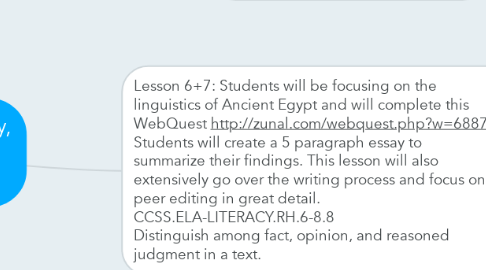Ancient Egyptian Society, History and Culture- Grade 6 Social Studies
by Josh Kessler

1. Lesson 1: What did Ancient Egypt actually look like? What ideas and images come to your mind when you think about ancient Egypt? Where in the world is Egypt located? What is the land and climate of Egypt like? Also, show this video https://www.youtube.com/watch?v=9gD0K7oH92U on Mummies to activate interest and create a K-W-L to pre-asses students knowledge CCSS.ELA-LITERACY.RH.6-8.2 Determine the central ideas or information of a primary or secondary source; provide an accurate summary of the source distinct from prior knowledge or opinions.
2. Lesson 2: Ancient Egyptian Trade- Begin by having students fill in a Cause + Effect Graphic organizer to connect Egypt's location in the Middle East with the vast amount of trade being done. The Graphic Organizer we will use can be found here http://www.readwritethink.org/files/resources/lesson_images/lesson1035/cause.pdf We will be reading and analyzing an article as a class to gather this information, article found at http://adventure.howstuffworks.com/nile-river2.htm We will also be focusing on economic principle to do with trade as well, incorporating mathematical principles. CCSS.ELA-LITERACY.RH.6-8.3 Identify key steps in a text's description of a process related to history/social studies (e.g., how a bill becomes law, how interest rates are raised or lowered). CCSS.MATH.CONTENT.6.SP.B.4 Display numerical data in plots on a number line, including dot plots, histograms, and box plots.
3. Lesson 8: We will focus on Egyptian innovation, this will be linked back to the trade knowledge of lesson 2. We will learn about the ability of Ancient Egyptians to make Papyrus and will create our own "paper" as a classroom as a kinesthetic way of learning this information and we will break down how much harder this would have been with the tools ancient Egyptians had at their disposal CCSS.ELA-LITERACY.RH.6-8.3 Identify key steps in a text's description of a process related to history/social studies (e.g., how a bill becomes law, how interest rates are raised or lowered).
4. Lesson 10: Field Trip. Students will pay a visit to San Francisco's Legion of Honor fine arts museum, specifically in order to see their Mummy display. Students will first make predictions regarding real mummies look like and that perform a write up explaining what they were accurate about, what differed, and further questions they have regarding mummies.
5. Lesson 9: We will be discussing Egyptian Mythology, with an emphasis on their god Ra. This will be a time to compare and contrast major religions of the modern world with that of Ancient Egypt. Students will build upon what they know of religions today with that of believing in a god like Ra. This will help bridge the modern world with the ancient and force students to contemplate why a religion may go away over time. The following printable will help students take notes during this lesson http://www.eslprintables.com/vocabulary_worksheets/countries_and_nationalities/egypt/Egypt_Gods_and_Goddess_613565/
6. Lesson 3+4: What was life like for the people of Ancient Egypt? What was the class system like. We will compare and contrast this class system with classes in Modern America using this graphic organizer, which can be found here http://www.readwritethink.org/files/resources/lesson_images/lesson275/compcon_chart.pdf We will watch the following video to begin learning about Pyramids https://www.youtube.com/watch?v=8bYRy_wZEJI Students will independently explore the following website to learn more about how Egyptian Pyramids affected their society at large, http://www.history.com/topics/ancient-history/the-egyptian-pyramids CCSS.ELA-LITERACY.RH.6-8.5 Describe how a text presents information (e.g., sequentially, comparatively, causally).
7. Lesson 5: This lesson will focus on different Pharaohs of Egypt. Each student will be assigned a different Pharaoh and independently research, small groups will be created and students will jigsaw what they learned with their group, each group will be created to have no duplicates. Students will be required to use both primary and secondary sources. CCSS.ELA-LITERACY.RH.6-8.9 Analyze the relationship between a primary and secondary source on the same topic.
8. Lesson 6+7: Students will be focusing on the linguistics of Ancient Egypt and will complete this WebQuest http://zunal.com/webquest.php?w=68877 Students will create a 5 paragraph essay to summarize their findings. This lesson will also extensively go over the writing process and focus on peer editing in great detail. CCSS.ELA-LITERACY.RH.6-8.8 Distinguish among fact, opinion, and reasoned judgment in a text.


